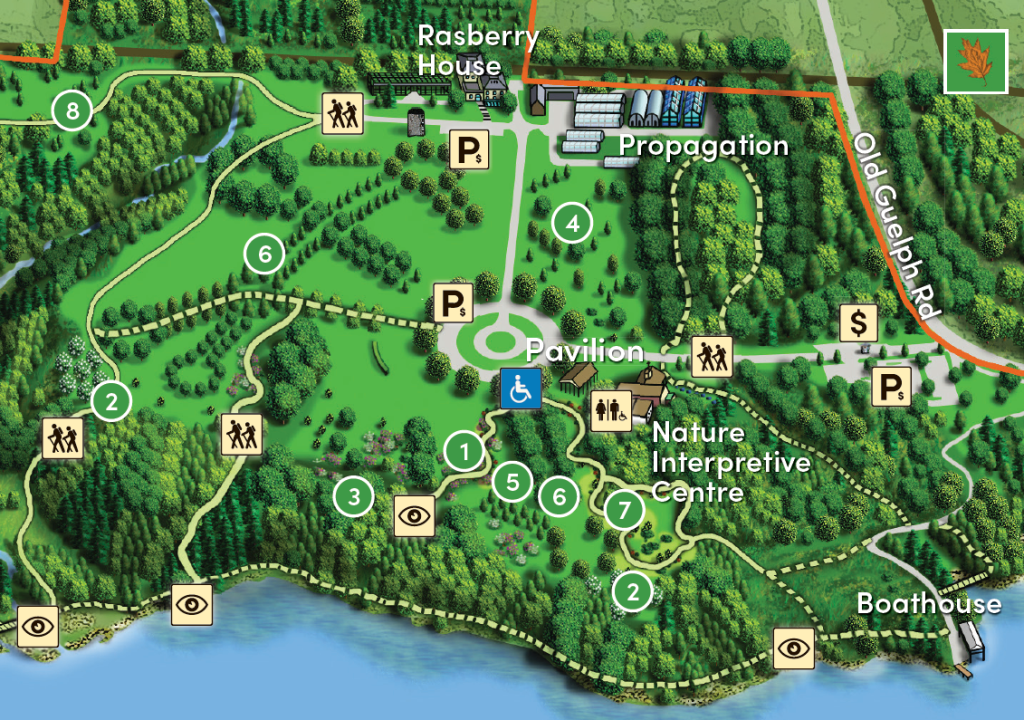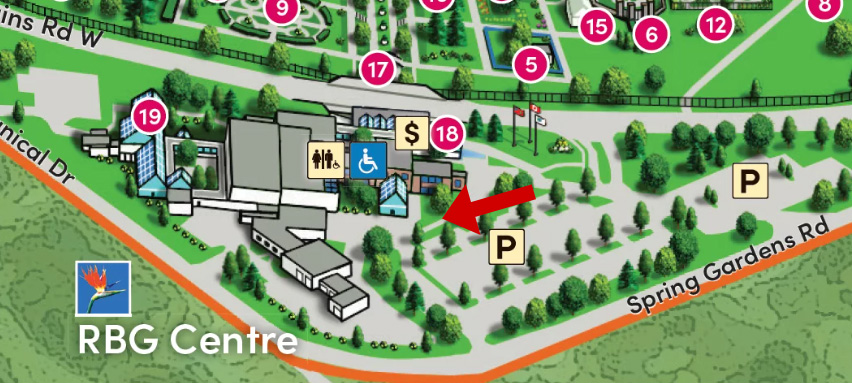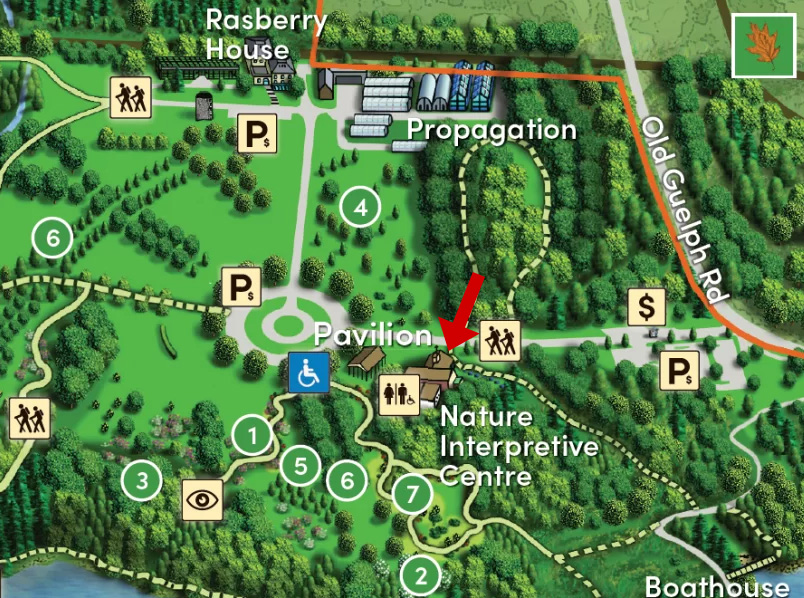| Membership | Price (+HST) |
|---|---|
| Single | $85/year |
| Single Plus | $120/year |
| Family | $130/year |
| Family Plus | $175/year |
| Contributing | $300/year |
| Supporting | $600/year |
| Sustaining | $1,000/year |
| Benefactor's Circle | $2,500/year |
| Director's Circle | $5,000/year |
| President's Circle | $10,000/year |
Lilacs
The Katie Osborne Lilac Garden
Peak Interest: May
Located in the Arboretum (16 Old Guelph Road, Hamilton)
Experience one of the largest and most diverse lilac collections in the world.
Every May, A heavenly fragrance drifts through Royal Botanical Gardens’ Arboretum, marking the official start of lilac season! RBG visitors can experience one of the largest, most magnificent and diverse collections in the world as it reaches peak bloom.
The Katie Osborne Lilac Collection in the Lilac Dell is a popular seasonal attraction, providing visitors with weeks of delightful springtime colour and fragrance.
Bloom Watch
With a number of different varieties blooming at different times, the lilacs often look beautiful for multiple weeks in May.
Check back frequently during bloom season for updates.
Lilac Collection
Current status: Not in bloom.
Historic Bloom Dates at the Arboretum
Note: bloom dates can vary drastically from year to year. Check back for our “bloom watch” updates.
| Year | Date of Peak Bloom |
|---|---|
| 2023 | Week of May 17 |
| 2022 | Week of May 22 |
| 2021 | Week of May 23 |
| 2020 | Week of May 31 |
| 2019 | Week of May 23 |
| 2018 | Week of May 27 |
| 2017 | Week of May 14 |
| 2016 | Week of May 22 |
Plan Your Visit to the Lilacs
The Arboretum holds the Katie Osborne Lilac Collection, one of the largest and most diverse lilac collection in the world. The lilac dell is a must-visit during peak bloom!
Admission and parking required. Parking at the Arboretum is very limited; pre-registration is required.
Admission Tickets
| Ticket Type | Price |
|---|---|
| Single Garden Admission | $10 (+HST) (Age 2 and under FREE) |
| RBG Members | FREE See your membership level for number of visitors included |
Parking Reservations
| Parking Type | Price |
|---|---|
| Arboretum Parking (time-ticketed) |
$10 (Free for RBG Members) Space is very limited; please pre-book online |
| Shuttle from RBG Centre (available weekends May 11 to 26) |
Free with admission or membership Requires pre-purchased admission or membership to ride. See details below. |
Parking at the Arboretum is very limited. Timed-ticketing parking will be in place to help decrease traffic and improve the safety of all visitors.
If you plan on parking at the Arboretum, we recommend starting with your online parking reservation to ensure the date / time you wish to join us is available before adding your admission to your cart.
Parking remains free for RBG members displaying their membership card and parking pass, however members should also pre-book their parking to avoid disappointment as spaces during peak bloom will fill up quickly.
The Arboretum is located at 16 Old Guelph Road, Hamilton ON.
Parking is available in 3 lots: Rasberry House (north, ~400m to lilacs), Parking Circle (central) and Entry Gate (east, ~400m to lilacs). Your parking reservation does not guarantee a space in any specific lot; you will be directed upon arrival. See the image below to familiarize yourself with the locations, and the distance to various collections. Accessible parking spaces are available in the Parking Circle.

The shuttle will pick up outside RBG Centre, located at 680 Plains Road W. Burlington ON.
Admission tickets are required to board the RBG shuttle (scanned before boarding). Pre-purchase your admission online, or at RBG Centre upon arrival.
Shuttle departure times: The Shuttle bus runs weekends only May 11 to 26.
Shuttle Schedule
- First shuttle leaves RBG Centre: 10:15 a.m.
- Run approximately every 15-20 minutes
- Final shuttle leaves the Arboretum: 7:30 p.m.
NOTE: with the exception of service animals, dogs are not permitted on the RBG shuttle bus. Please reserve your parking space to enjoy the Arboretum with your four-legged friend.
Shuttle Locations
Park at RBG Centre, 680 Plains Road W. Burlington ON. The shuttle will pick up and drop off outside RBG Centre.

At the Arboretum (3.1km drive), the shuttle will pick up and drop off in a designated space outside the Nature Interpretive Centre.

The Arboretum is open daily during bloom season from 10 a.m. to 8 p.m.
Your time-ticketed parking indicates your arrival window; we ask visitors limit their visit to 2 hours to allow space for other visitors to see the blooms.
The weekend shuttle runs from 10:15 a.m. to 7:30 p.m. See exact departure times in the “about the shuttle” section above.
What’s in Bloom?
Blooms are ever-changing in RBG’s five cultivated garden areas and nature sanctuaries. Check back to learn what’s blooming now or see the blooms calendar for a rough estimation of what to expect in a particular season.
History of Lilacs at RBG
Once located on the eastern shore of Cootes Paradise, the lilac (Syringa) collection, comprising of 230 plants, was moved to the Arboretum in 1959 to accommodate the development of Highway 403. By 1964 Colin Osborne of Hamilton established the Katie Osborne Lilac Trust to honour the memory of his wife with the intention of expanding and maintaining the collection for the future. Today, the collection displays over 500 individual plants representing several hundred cultivars, meaning RBG’s collection is one of the most diverse collections of lilacs on the planet.
About Lilacs
Lilacs are deciduous shrubs grown for their showy and fragrant blooms in spring. Plant lilacs in well-drained soil in a location that receives full sun for six to eight hours a day. Some cultivars (cultivated varieties) with dark purple flowers will appreciate some shade to prevent flower colours from fading. Lilacs appreciate good air circulation as this is beneficial in combatting diseases such as powdery mildew which is non-life threatening but unsightly. Prompt removal of faded flowers (termed thyrses) before seed set is critical as this will increase bloom in the following year. Pruning immediately after flowering should remove dead, diseased and rubbing wood and encourage air flow through the plant. Maintaining lilacs at a height of six to nine feet keeps shrubs manageable and maintains the fragrant flowers at about head/nose height. To renovate an old lilac or one that is in bad shape, remove one-third of the oldest wood down to the ground in year one, halve the remaining wood in year two and the remainder in year three. Lilacs can be easily transplanted and moved. The best time to do this is August when the plants are dormant and retaining as much of the plant’s root ball as possible.
Cultivars
Currently, it is thought that approximately 21 different species of lilac can be found in the wild. The geographic range of wild species includes eastern Asia, particularly Japan and China, with two lilac species native to Europe. Of the European species, Syringa josikae inhabits parts of Hungary and Romania while Syringa vulgaris is native to the Balkan mountain regions. It is this latter species and its cultivars that have captured our imagination and become the most beloved lilac as a garden introduction. As a result, cultivars of Syringa vulgaris form the basis of RBG’s Lilac Collection.
Cultivars of common lilac (Syringa vulgaris) are often referred to as single or double flowered French hybrids. This is in reference to the prolific hybridizing work of Victor Lemoine and his sons who had a nursery based in the Lorraine province of France. They worked with many different plant genera, creating spectacular new cultivars that have stood the test of horticultural time. Lemoine’s work with lilacs is shown through single and double French hybrids. Look for examples of his plants in the Lilac Walk amongst the single and double French hybrids section. Common lilac cultivars are mid-bloom season lilacs.
Not content with just single and double French hybrids, Lemoine added the species Syringa oblata to his collection and began crossing this plant with Syringa vulgaris. The result was the introduction of the hyacinth lilac (Syringa ×hyacinthiflora and cultivars). Manitoba lilac breeder Frank Leith Skinner also contributed to hyacinth lilacs. In this section of the Lilac Walk, look out for S. ×hyacinthiflora ‘Maiden’s Blush’ of which the fragrance is sublime. Hyacinth lilacs are early bloom season lilacs.
Preston lilacs (Syringa ×prestoniae) are Canada’s contribution to the lilac world. Isabella Preston, Canada’s first female hybridizer (after whom these lilacs are named) crossed Syringa villosa and Syringa komarowii to create a whole new group of late blooming (Villosae Group) hybrid lilacs. Preston hybrids differ from common and hyacinth lilacs, being much larger shrubs and having noticeably different flowers, leaf shape and fragrance. As a result, these lilacs are extremely hardy and were bred intentionally with the Canadian climate in mind. You will notice when in the Preston Hybrid section of the Lilac Walk that she named many of her cultivars after the women of Shakespearian tales. Preston Hybrids are late bloom season lilacs.
Diversity and Colour
When planting a lilac garden, it makes good sense to combine a diversity of common, hyacinth and Preston lilacs. By combining these early, mid and late season bloom lilacs one can have lilacs in bloom for at least six weeks in spring in each year. When planting ‘en masse’ make sure you include white lilacs at intervals as this will really make your lilac flowers pop!
The most important ornamental quality of lilacs is colour. Flower colour can be very subjective and the range of colour makes its description difficult. In essence, not all lilacs are lilac! As a result, botanical garden curators, botanists, scientists, horticulturists and plant hybridizers around the world denote flower colour using a simple colour classification process termed the Wister Code. John Wister, an American horticulturist and International Lilac Registrar 1956-1975 proposed the following logical sequence of colour categories:
- White
- Violet
- Lilac
- Pinkish
- Magenta
- Purple
- Blueish
In addition, lilac flowers are classified as being either:
- Single – with four petals
- Double – with more than four petals
For this reason, if a lilac is denoted as being S III then it is internationally recognized as being a lilac with single blueish flowers. If it is D VII then it would be a double purple lilac.
Identification
When trying to identify or confirm the identity of a cultivar in precise detail or when a plant hybridizer introduces a new lilac cultivar colour, description becomes even more critical as an identification tool. When precise colour descriptions are required, staff at RBG refer particularly to the 1966 Royal Horticultural Society Colour Chart containing 808 colour chips which are used to accurately determine flower colour.
Scent
Although lilacs are known for their intoxicating scent, not all lilacs are equally fragrant. Common lilac has a strong but not overpowering scent while some of the wild species from the far-east have a spicier fragrance, somewhat reminiscent of cloves. The tree lilacs Syringa reticulata and Syringa pekinensis have a more musk-like fragrance that is not always agreeable to some people. When planting a lilac garden consider planting cultivars of common lilac with some of the spicier smelling wild cousins to appreciate the diversity of fragrance. Character of scent may also change somewhat from season to season based on changes in annual climate. A cool spring and summer may yield different fragrance levels compared to a hot spring and summer. As with wine which may have vintage years in taste, the same can be said of lilacs with fragrance. Some years are just better than others!

Support Horticulture at RBG
The care and growth of our horticultural collections are possible thanks to the generous support of RBG Members and donors. With a donation to Royal Botanical Gardens, you can ensure an active, vibrant and healthy future for the children of today and tomorrow through our horticultural and conservation projects.
Royal Botanical Gardens (RBG) is the largest botanical garden in Canada, a National Historic Site, and registered charitable organization with a mandate to bring together people, plants and nature.
More to Do, Naturally
Other Major Collections
As a botanical garden, Royal Botanical Gardens acquires, collects, researches, exhibits, conserves and interprets a living horticultural collection.
Bloom Calendar
Plants of interest are ever-changing in RBG’s five cultivated garden areas and nature sanctuaries. Check back to learn what’s blooming now or see the blooms calendar for a rough estimation of what to expect each season.
Events Calendar
Discover what’s happening in the gardens! Some programs, events, and experiences listed below are included in general admission / membership, while others require separate registration.
















